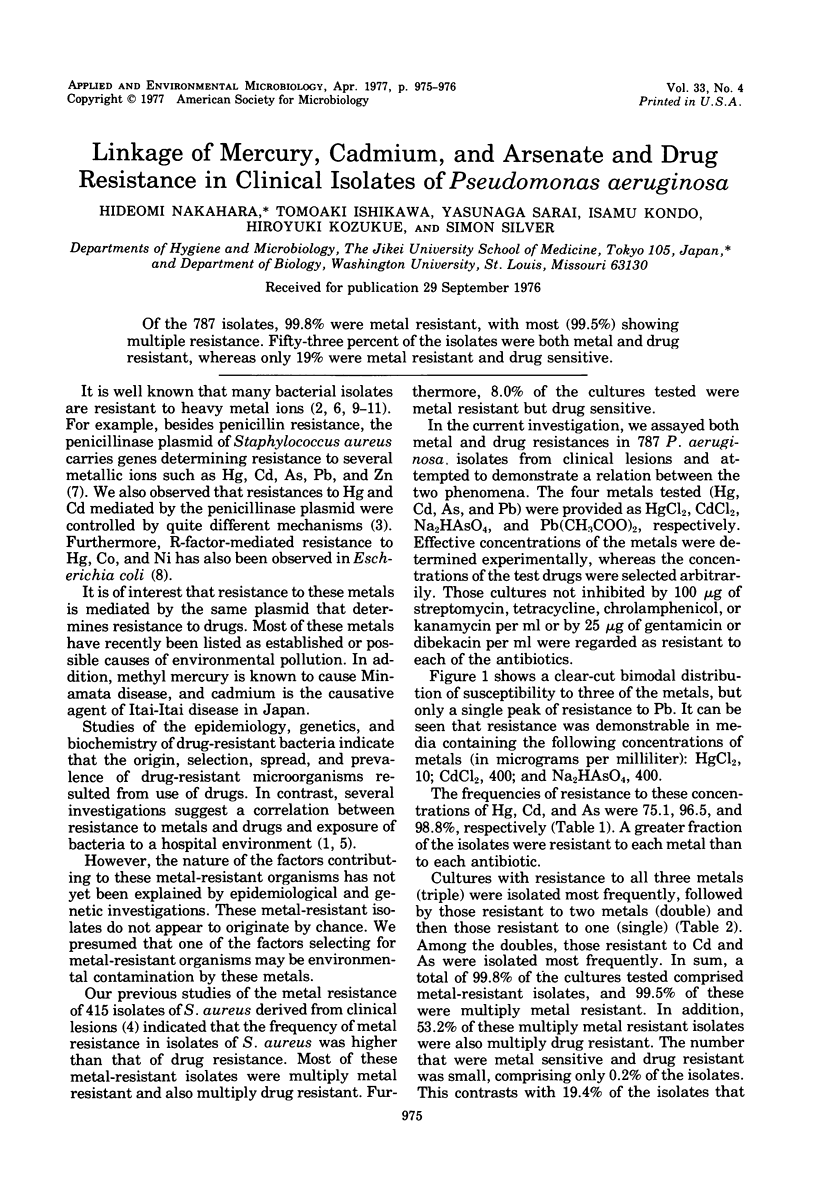Abstract
Of the 787 isolates, 99.8% were metal resistant, with most (99.5%) showing multiple resistance. Fifty-three percent of the isolates were both metal and drug resistant, whereas only 19% were metal resistant and drug sensitive.
Full text
PDF

Selected References
These references are in PubMed. This may not be the complete list of references from this article.
- Hall B. M. Distribution of mercury resistance among Staphylococcus aureus isolated from a hospital community. J Hyg (Lond) 1970 Mar;68(1):111–119. doi: 10.1017/s0022172400028564. [DOI] [PMC free article] [PubMed] [Google Scholar]
- Hamdy M. K., Noyes O. R. Formation of methyl mercury by bacteria. Appl Microbiol. 1975 Sep;30(3):424–432. doi: 10.1128/am.30.3.424-432.1975. [DOI] [PMC free article] [PubMed] [Google Scholar]
- Kondo I., Ishikawa T., Nakahara H. Mercury and cadmium resistances mediated by the penicillinase plasmid in Staphylococcus aureus. J Bacteriol. 1974 Jan;117(1):1–7. doi: 10.1128/jb.117.1.1-7.1974. [DOI] [PMC free article] [PubMed] [Google Scholar]
- MOORE B. A new screen test and selective medium for the rapid detection of epidemic strains of Staph. aureus. Lancet. 1960 Aug 27;2(7148):453–458. doi: 10.1016/s0140-6736(60)91591-9. [DOI] [PubMed] [Google Scholar]
- Nelson J. D., Blair W., Brinckman F. E., Colwell R. R., Iverson W. P. Biodegradation of phenylmercuric acetate by mercury-resistant bacteria. Appl Microbiol. 1973 Sep;26(3):321–326. doi: 10.1128/am.26.3.321-326.1973. [DOI] [PMC free article] [PubMed] [Google Scholar]
- Novick R. P., Roth C. Plasmid-linked resistance to inorganic salts in Staphylococcus aureus. J Bacteriol. 1968 Apr;95(4):1335–1342. doi: 10.1128/jb.95.4.1335-1342.1968. [DOI] [PMC free article] [PubMed] [Google Scholar]
- Smith D. H. R factors mediate resistance to mercury, nickel, and cobalt. Science. 1967 May 26;156(3778):1114–1116. doi: 10.1126/science.156.3778.1114. [DOI] [PubMed] [Google Scholar]
- Summers A. O., Silver S. Mercury resistance in a plasmid-bearing strain of Escherichia coli. J Bacteriol. 1972 Dec;112(3):1228–1236. doi: 10.1128/jb.112.3.1228-1236.1972. [DOI] [PMC free article] [PubMed] [Google Scholar]
- Tonomura K., Maeda K., Futai F., Nakagami T., Yamada M. Stimulative vaporization of phenylmercuric acetate by mercury-resistant bacteria. Nature. 1968 Feb 17;217(5129):644–646. doi: 10.1038/217644b0. [DOI] [PubMed] [Google Scholar]
- Walker J. D., Colwell R. R. Mercury-resistant bacteria and petroleum degradation. Appl Microbiol. 1974 Jan;27(1):285–287. doi: 10.1128/am.27.1.285-287.1974. [DOI] [PMC free article] [PubMed] [Google Scholar]


